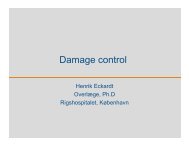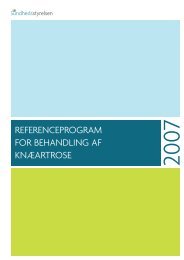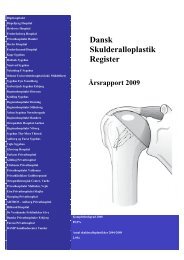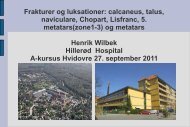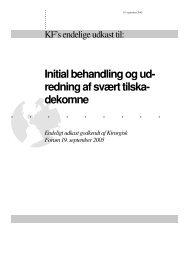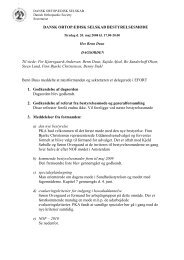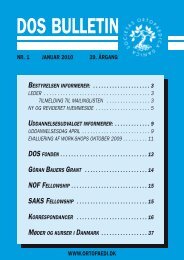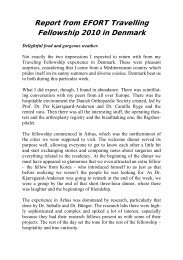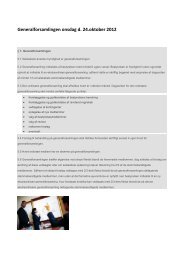DOS BULLETIN - Dansk Ortopædisk Selskab
DOS BULLETIN - Dansk Ortopædisk Selskab
DOS BULLETIN - Dansk Ortopædisk Selskab
Create successful ePaper yourself
Turn your PDF publications into a flip-book with our unique Google optimized e-Paper software.
2010-378_<strong>DOS</strong> nr. 3 2010 29/09/10 10:08 Side 136<br />
Effect of Preoperative Methylprednisolone on Pain<br />
and Recovery after Total Knee Arthroplasty: A Randomized,<br />
Double-blind, Placebo-controlled Trial<br />
Troels H. Lunn, Henrik Husted, Kristian Stahl Otte, Billy B Kristensen,<br />
Lasse Ø Andersen, Lasse Ø Andersen, Henrik Kehlet<br />
Dep. of anaesthesiology & Dep. of Orthopedics, Hvidovre University<br />
Hospital, Dep. of surgical pathophysiology, Rigshospitalet<br />
Background: Several postoperative clinical symptoms including pain are related<br />
to the inflammatory stress response caused by the surgical trauma. Glucocorticoids<br />
may provide positive analgesic effects by suppressing the inflammatory<br />
response as demonstrated in many procedures. Unfortunately, no data exists in<br />
total knee arthroplasty (TKA), where inflammation and pain is dominant.<br />
Purpose: We hypothesized that a single, high- dose of methylprednisolone (MP)<br />
would improve acute, postoperative analgesia after TKA.<br />
Methods: Patients scheduled for unilateral, primary TKA were consecutively<br />
included in a randomized, double-blind, placebo- controlled trial receiving preoperative<br />
MP 125 mg IV or placebo (saline). The primary endpoint was pain<br />
after walking 5 meters, and secondary endpoints were pain at rest, pain upon 45°<br />
flexion of the hip with the leg straight, and pain upon 45 ° knee flexion. Assessment<br />
was performed preoperatively and 2, 4, 6, 24, 28, 32 and 48h after surgery,<br />
and in a questionnaire from day 2 to 10, and at follow up on day 21 and day 30.<br />
Tertiary endpoints were postoperative nausea and vomiting (PONV), C-reactive<br />
protein (CRP), sleep quality, fatigue, rescue analgesic- and antiemetic requirements,<br />
length of stay (LOS) and side effects.<br />
Findings: Forty-eight included patients (24 in each group) all completed the trial.<br />
Pain scores were significantly lower in the MP group up to 32h postoperatively.<br />
Summarized pain scores (2-48h) were lower for all assessments: pain after<br />
walking (p=0.0002); pain at rest (p=0.002); pain upon flexion of the hip<br />
(p=0.016); and pain upon knee flexion (p=0.001). Fewer patients required rescue<br />
sufentanil in the PACU (p=0.017) and oxycodone requirement was lower from 0-<br />
24h (p=0.012). PONV-frequency and consumption of antiemetic was reduced<br />
(p



